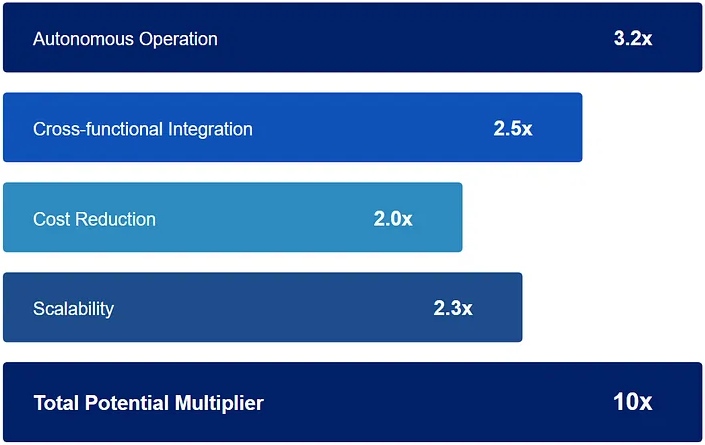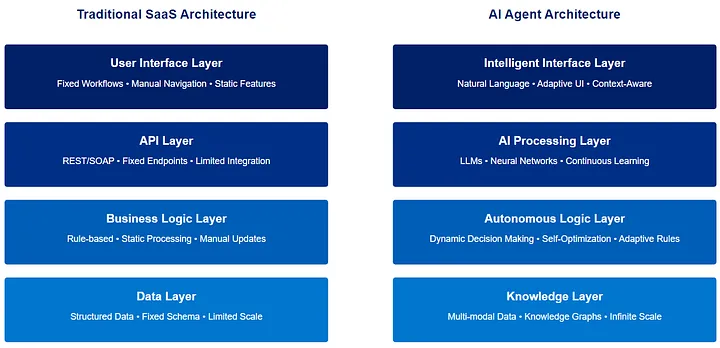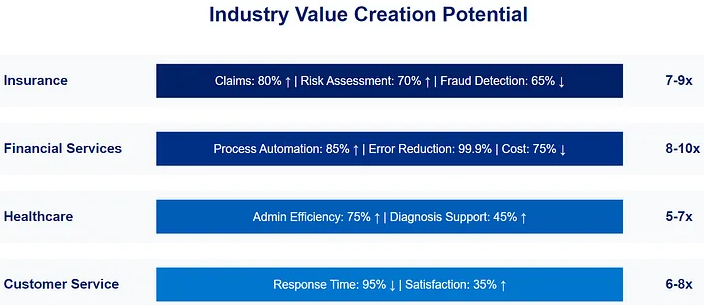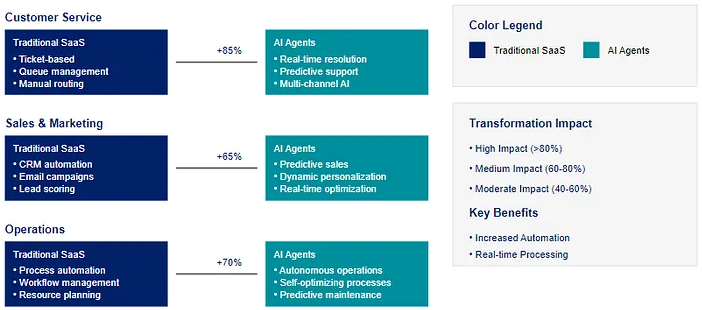overview
As we stand at the dawn of the AI Agent era, we are witnessing the early signals of what could become the most significant transformation in enterprise software history. While traditional SaaS has revolutionized software delivery and business operations over the past two decades, the emergence of AI agents represents a fundamental paradigm shift that could potentially deliver 5–10x greater value.
After spending two decades in technology consulting, business process transformation, enterprise software and watching the SaaS revolution unfold, I believe we are standing at the threshold of something even more transformative.
The SaaS market has been a remarkable success story, with projected global revenue of $328.20 billion in 2024 and an impressive CAGR of 19.30% expected to drive the market to $793.10 billion by 2029 (Source: Statista). While these numbers are substantial, they represent the optimization of traditional software delivery models. AI agents represent an entirely new paradigm that could dwarf these figures.
Understanding the Value Multiplier Effect

Understanding the Value Multiplier Effect. (Image Source: https://medium.com/)
- Process thousands of requests simultaneously
- Work continuously without breaks
- Learn and improve from every interaction
- Scale instantly when needed
- 24/7 Operation (3.0x)
- Parallel Processing Capability (0.2x)
- Continuous Learning & Improvement
- Zero Downtime & Instant Availability
- Work across multiple domains simultaneously
- Integrate information from various sources in real-time
- Make complex decisions by considering multiple factors
- Adapt to new scenarios without requiring updates or patches
- Context-switching elimination (1.5x)
- Integration efficiency gains (1.0x)
- Native cross-platform compatibility
- Real-time data synchronization
- Significantly lower marginal cost for additional tasks
- Reduced need for multiple specialized software licenses
- Lower training and onboarding costs
- Minimal infrastructure requirements
- License cost reduction (0.8x)
- Training cost elimination (0.6x)
- Support staff reduction (0.6x)
- Infrastructure optimization
- Instant deployment (0.8x)
- Minimal marginal cost scaling (1.0x)
- Automatic load balancing (0.5x)

- From: Static APIs and fixed workflows
- To: Dynamic, self-adjusting integration patterns
- Potential Impact: 75%+ faster integration cycles
- From: Batch processing and scheduled updates
- To: Continuous, real-time processing with autonomous decision-making
- Expected Impact: Orders of magnitude improvement in processing efficiency

Insurance Industry (Projected 7–9x Value Multiplier): As a traditionally data-intensive sector with highly structured processes, insurance stands to gain significant value from AI agent transformation. Having worked with insurance companies, I see enormous potential in with multiplier of 7–9x based on several key opportunity areas:
- Claims Processing: Potential for 80% efficiency gains through end-to-end automation of claims assessment, validation, and processing
- Risk Assessment: Estimated 70% improvement in accuracy through real-time data analysis and dynamic risk modeling
- Fraud Detection: Projected 65% reduction in fraudulent activities through advanced pattern recognition
Financial Services (8–10x projected multiplier): In my view, this sector is primed for the biggest transformation due to more immediate automation opportunities.
- Greater transaction volumes and standardized processes
- More mature digital infrastructure
Healthcare (5–7x projected multiplier):
- Lower multiplier reflects complexity of human-centered care
- Regulatory constraints may slow adoption
- Strong potential in administrative processes
Customer Service (6–8x projected multiplier):
- High potential in automated response systems
- Significant efficiency gains in query resolution
- Enhanced personalization capabilities
- Current: Human-dependent engagement models
- Future Potential: Omnipresent, context-aware engagement
- Expected Impact: 3–4x improvement in engagement metrics
- Current: Semi-automated processes
- Future Potential: Fully autonomous operations with human oversight
- Expected Impact: 5–6x efficiency gains
- Current: Rule-based systems with periodic updates
- Future Potential: Continuous, adaptive decision-making
- Expected Impact: 4–5x improvement in decision quality


- Legacy system compatibility
- Data standardization across platforms
- API and protocol harmonization
- Real-time synchronization requirements
- Processing large data volumes
- Maintaining response times under load
- Infrastructure scaling costs
- System reliability at scale
- Data fragmentation across systems
- Inconsistent data formats
- Historical data migration
- Real-time data access requirements
- System dependency risks
- Transition period vulnerabilities
- Fallback mechanism requirements
- Service interruption impacts
- Workforce adaptation challenges
- Process redesign requirements
- Training and skill gaps
- Cultural resistance
- Implementation cost overruns
- Hidden operational costs
- ROI timeline uncertainties
- Resource allocation challenges
- First-mover advantages vs. risks
- Competitive response uncertainty
- Market acceptance variables
- Industry disruption impacts
- Evolving regulatory landscape
- Compliance verification challenges
- Cross-border regulation complexity
- Audit trail requirements
- Data protection requirements
- Attack surface expansion
- Privacy regulation compliance
- Third-party risk management
- Start with low-risk processes
- Pilot programs before full deployment
- Incremental capability expansion
- Continuous feedback loops
- Human-in-the-loop systems
- Gradual automation increase
- Dual-running critical systems
- Progressive complexity handling
- Clear accountability structures
- Regular risk assessments
- Performance monitoring systems
- Compliance verification processes
The transition from SaaS to AI agents represents not just a technological shift but a fundamental reimagining of how businesses operate. While SaaS optimized existing processes, AI agents are creating entirely new possibilities. The potential for 5–10x greater value creation is not just theoretical — early adopters are starting to realize the potential.
This transformation will require careful consideration of technical, ethical, and organizational factors, but the potential rewards make it one of the most significant business opportunities of our time.
